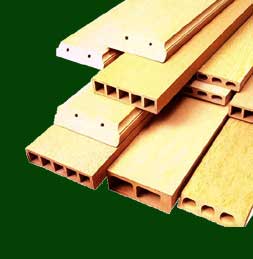Fiber-reinforced composite
The examples and perspective in this article may not include all significant viewpoints. (December 2010) |
A fiber-reinforced composite (FRC) is a composite building material that consists of three components: (i) the fibers as the discontinuous or dispersed phase, (ii) the matrix as the continuous phase, and (iii) the fine interphase region, also known as the interface.[1][2] This is a type of advanced composite group, which makes use of rice husk, rice hull, and plastic as ingredients. This technology involves a method of refining, blending, and compounding natural fibers from cellulosic waste streams to form a high-strength fiber composite material in a polymer matrix. The designated waste or base raw materials used in this instance are those of waste thermoplastics and various categories of cellulosic waste including rice husk and saw dust.

FRC is high-performance fiber composite achieved and made possible by cross-linking cellulosic fiber molecules with resins in the FRC material matrix through a proprietary molecular re-engineering process, yielding a product of exceptional structural properties.
Through this feat of molecular re-engineering selected physical and structural properties of wood are successfully cloned and vested in the FRC product, in addition to other critical attributes to yield performance properties superior to contemporary wood.
This material, unlike other composites, can be recycled up to 20 times, allowing scrap FRC to be reused again and again.
The failure mechanisms in FRC materials include delamination, intralaminar matrix cracking, longitudinal matrix splitting, fiber/matrix debonding, fiber pull-out, and fiber fracture.[1]
Difference between wood plastic composite and fiber-reinforced composite:
| Features | Plastic lumber | Wood plastic composite | FRC | Wood |
|---|---|---|---|---|
| Recyclable | Yes | No | Yes | Yes |
| House Construction | No | No | Yes | Yes |
| Water Absorption | 0.00% | 0.8% and above | 0.3% and below | 10% and above |
Properties
| Tensile Strength | ASTM D 638 | 15.9 MPa |
| Flexural Strength | ASTM D 790 | 280 MPa |
| Flexural Modulus | ASTM D 790 | 1582 MPa |
| Failure Load | ASTM D 1761 | 1.5 KN - 20.8 KN |
| Compressive Strength | 20.7MPa | |
| Heat Reversion | BS EN 743 : 1995 | 0.45% |
| Water Absorption | ASTM D 570 | 0.34% |
| Termite Resistant | FRIM Test Method | 3.6 |
Application
There are also applications in the market, which utilize only waste materials. Its most widespread use is in outdoor deck floors, but it is also used for railings, fences, landscaping timbers, cladding and siding, park benches, molding and trim, window and door frames, and indoor furniture. See for example the work of Waste for Life, which collaborates with garbage scavenging cooperatives to create fiber-reinforced building materials and domestic problems from the waste their members collect: Homepage of Waste for Life
See also
References
- ^ a b WJ Cantwell, J Morton (1991). "The impact resistance of composite materials -- a review". Composites. 22 (5): 347–62. doi:10.1016/0010-4361(91)90549-V.
- ^ Serope Kalpakjian, Steven R Schmid. "Manufacturing Engineering and Technology". International edition. 4th Ed. Prentice Hall, Inc. 2001. ISBN 0-13-017440-8.
